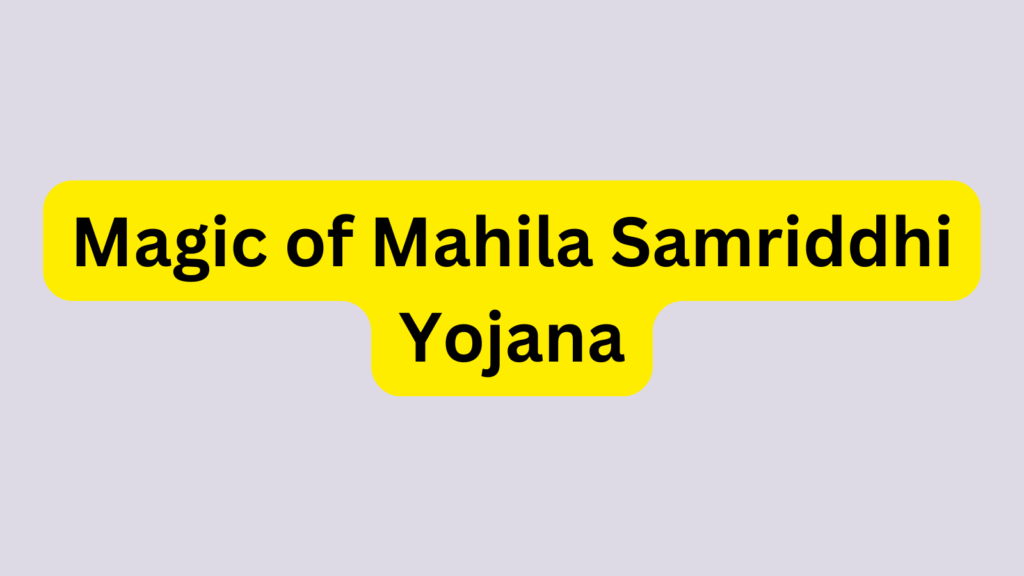Imagine a world where every woman, no matter her circumstances, holds the keys to her own prosperity. A world where financial shackles loosen, and dreams take flight on the wings of possibility. That’s the heartbeat of the Mahila Samriddhi Yojana, a transformative initiative from India’s landscape of empowerment, weaving a tapestry of hope for women who’ve long lingered in the shadows of opportunity.

A Beacon for the Unsung Heroes
At its core, this isn’t just a scheme—it’s a lifeline. Launched with a vision to uplift women from marginalized corners, Mahila Samriddhi Yojana targets those whose voices are rarely heard: rural mothers, artisans, and breadwinners from backward classes or below-poverty-line households. Picture a woman in a remote village, her hands skilled at crafting but her wallet empty. This program steps in, not with charity, but with a chance—a loan, a nudge, a spark to ignite her entrepreneurial fire.
Under the National Backward Classes Finance and Development Corporation (NBCFDC), this gem of an initiative rolled out on October 2, 1993, like a quiet revolution. It’s not about handouts; it’s about hand-ups. Women aged 18 to 55, tethered to Self-Help Groups (SHGs), can access up to ₹1,00,000 at a whisper-soft interest rate of 4% per annum. Repayment stretches over four years, with a generous six-month breather to get started. Entire SHGs? They can tap into ₹15,00,000 collectively, splitting the bounty based on need. It’s practical, it’s thoughtful, and it’s built for real lives.
Beyond Money: Crafting Confidence
What sets this apart from the usual bureaucratic maze is its soul. Yes, the funds matter—whether for a looms-and-threads venture or a small livestock dream—but the scheme doesn’t stop there. It wraps its arms around these women with training, teaching them the ropes of financial know-how and business grit. Ever tried running a shop with no clue how to balance the books? That’s where Mahila Samriddhi Yojana shines, turning novices into savvy trailblazers.
Take Radha, a fictional yet familiar figure. She’s 34, a mother of two, her family scraping by on less than ₹3,00,000 a year. Through her SHG, she secures a loan, buys a sewing machine, and stitches her way to stability. No collateral demanded, no sky-high interest haunting her nights—just a fair shot at dignity. That’s the promise in action.
A New Chapter in Delhi’s Story
Fast forward to 2025, and the name “Mahila Samriddhi Yojana” takes on fresh hues. The Bharatiya Janata Party (BJP), riding the wave of its Delhi Assembly election win, unfurls a bold twist. This isn’t about loans anymore—it’s about direct lifelines. Announced for a March 8, 2025, debut under Chief Minister Rekha Gupta, the plan pledges ₹2,500 monthly to women from economically weaker sections. Pregnant? There’s ₹21,000 plus a nutrition kit. Cooking at home? Subsidized LPG cylinders lighten the load. It’s less about seeding businesses and more about steadying the ground beneath their feet.
Two visions, one name—a testament to how this concept evolves with the times. To see the differences at a glance, here’s a snapshot:
| Feature | NBCFDC Scheme | Delhi 2025 Plan |
|---|---|---|
| Goal | Spark entrepreneurship | Ease daily burdens |
| Aid Type | Loans up to ₹1,00,000 | ₹2,500/month cash |
| Extras | Training and SHG support | Nutrition kits, LPG subsidies |
| Target | Rural women in SHGs | Urban Delhi’s EWS women |
Both, though, whisper the same truth: women’s strength is a nation’s backbone.
Why It Matters Now
In a country where rural women often wrestle with moneylenders charging 20% or more, a 4% loan feels like a miracle. In a city like Delhi, where inflation gnaws at every paycheck, ₹2,500 a month isn’t just cash—it’s breathing room. Data backs the impact: since its inception, the NBCFDC scheme has funneled crores into SHGs, lifting countless families. The Delhi promise, still unfolding as of February 22, 2025, could redefine urban welfare if it holds firm.
Yet, it’s not flawless. Access isn’t universal—paperwork snarls and awareness gaps leave some behind. Still, the intent burns bright: empower, don’t pity; enable, don’t entangle.
Joining the Journey
Curious how to step in? Here’s the rundown:
- For NBCFDC’s Path: Reach out through State Channelizing Agencies or visit the NBCFDC portal with ID proofs and SHG papers in hand.
- For Delhi’s Promise: Stay tuned—eligibility details are sharpening as March 8, 2025, nears.
Either way, it’s less about red tape and more about reaching for what’s possible.
The Ripple Effect
Mahila Samriddhi Yojana isn’t just a policy—it’s a story of resilience. It’s the widow who turns her backyard into a poultry hub, the young mother who trades despair for a tailoring needle, the urban dweller who stretches ₹2,500 into school fees. Every rupee ripples, touching lives beyond the ledger. Here are five ways it transforms:
- Seeds Stability: Loans or cash—both plant roots for families to stand tall.
- Ignites Ambition: Rural women dream bigger with tools and training.
- Eases Burdens: Delhi’s aid softens the edges of urban grind.
- Builds Skills: Knowledge becomes power, not just rupees.
- Sparks Hope: Every success story lights the way for another.
So here’s to the women it serves—not as beneficiaries, but as architects of their own futures. And here’s to a scheme that dares to see them not as they are, but as they could be. In a world quick to count women out, Mahila Samriddhi Yojana counts them in.